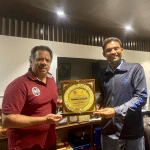Sao Paulo, Oct 2 (AFP/APP): Some spend crazy amounts, others line up at dawn or gather at informal swap meets — anything to satisfy a passion that combines love of soccer, this year’s World Cup in Qatar and the ever-popular pursuit of Panini soccer stickers.
Sold in 150 countries, the stickers seem to arouse a particular frenzy in Latin America because of the possibility that this might be the last World Cup for Argentinian football icon Lionel Messi, who is 35, or that a Latin American side might finally break Europe’s hold on the Cup.
“Almost everything I earn, that anyone lends me, or that they owe me, I invest in the stickers,” Hilda Losada, who is Argentinian, told AFP.
The 68-year-old grandmother, who is working to complete her album of nearly 700 stickers — and her grandson’s as well — has been waiting in line since 5:00 am for the opening of a store in Buenos Aires.
The stickers have been in short supply for days in Argentina, with the government itself intervening to mediate between the Italian publisher and frustrated shopkeepers who want a bigger piece of the juicy trade.
“This is one of the few places where you can find them now,” Losada said, standing in a long line of collectors.
Not everyone will leave happy, and some are vowing to turn to the black market, if need be, even if it costs twice the official price of about $1 for five stickers.
Her family tells her she’s crazy, but Losada pays them no mind as she happily pursues her fascination. She has been collecting the cards every four years since she was “a little girl,” she insists, even if galloping inflation in Argentina — currently at 56 percent — does not make that easy.
“Argentina is nearly always in an economic crisis,” shrugged the shop owner, Leila Edul. “But now, with these stickers… money somehow appears out of nowhere.”
That is true despite the soaring price of a packet since the 2018 World Cup in Russia. In Brazil, the cost has doubled, from 37 US cents to 74 cents.
Follow the PNI Facebook page for the latest news and updates.








